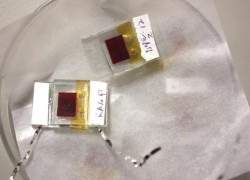
Translucent windows harvesting the sun’s energy more efficiently than our current solar panels, cell phones that charge when exposed to ambient light and lights powered by the sun on a cloudy day may not be figments of scientists’ imagination. In the not too distant future, these things could exist due to research at the NC State U. College of Textiles.
According to Maqbool Hussain, a graduate student working on the new solar technology, there are many ideal renewable energy sources, but solar energy is the best and most viable renewable energy source.
“Only one percent of the light that shines on Earth is enough to power most civilized countries,” Hussain said.
The breakthrough is called a Dye-Sensitized Solar Cell (DSSC). The researchers have developed this dye that bonds to Titanium Dioxide, a semiconductor, according to Ahmed El-Shafei, the professor leading the research. This dye absorbs photons from sunlight, which excite the dye’s electrons, according to El-Shafei. These electrons then transfer to the Titanium Dioxide semiconductor and go through a circuit, which generates a current, Hussain said.
There are a few aspects of the DSSC that make them a viable option for everyone, but one of the most important aspects is the price difference compared to regular solar panels.
“Other solar panels use costly inorganic materials and need very special preparation methods,” Hammad Cheema, another graduate student working on the project, said. “Our Dye-Sensitized Solar Cells are much simpler and cheaper.”
According to El-Shafei, DSSC’s are around 60 to 70 percent cheaper than other solar panels.
Aside from the attractive price difference, another aspect of a DSSC is its ability to absorb photons from ambient light as well as direct sunlight. According to El-Shafei, this means the Dye Sensitized Solar Cell is able to use the sun’s energy while not being in direct contact with the sun’s rays. This also means the DSSC can harvest energy from the sun on a cloudy or rainy day. According to El-Shafei, regular solar panels collect different amounts of energy throughout the day, peaking at noon, whereas the DSSC collects the maximum amount of energy throughout the day, due to its ability to capture ambient light.
The final aspect of the Dye-Sensitized Solar Cell that allows it to trump regular solar panels is the fact that a dilute solution of the dye can be used in the cell, allowing the cell to be transparent, according to Cheema. This means that windows, building facades and touch screens on cell phones have the capacity to harvest solar energy with the DSSC technology, according to El-Shafei.
The research team has already produced a dye that is 14 percent more efficient than the current state of the art dye, but their goal is to increase this to 30 percent by the end of the year. According to El-Shafei, this would be a game changer in the solar energy industry. Companies are already interested in their current DSSC and are working to make a deal, which would bring money to N.C. State.
